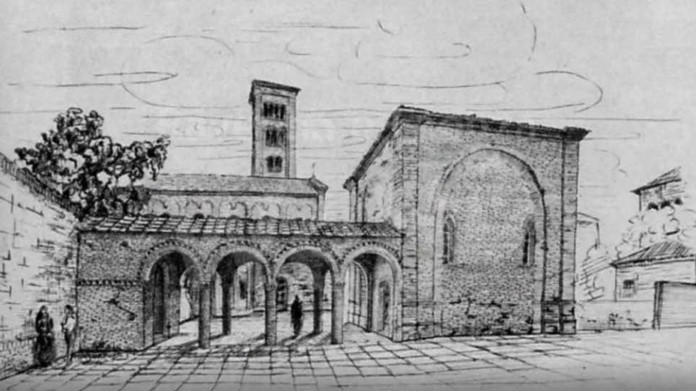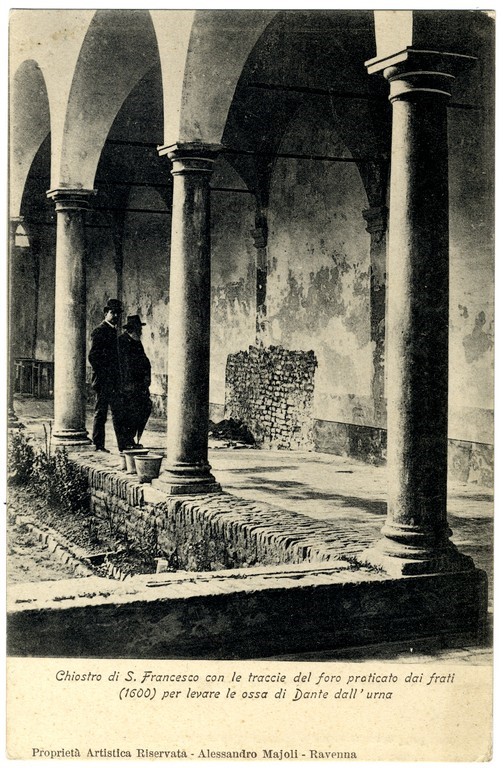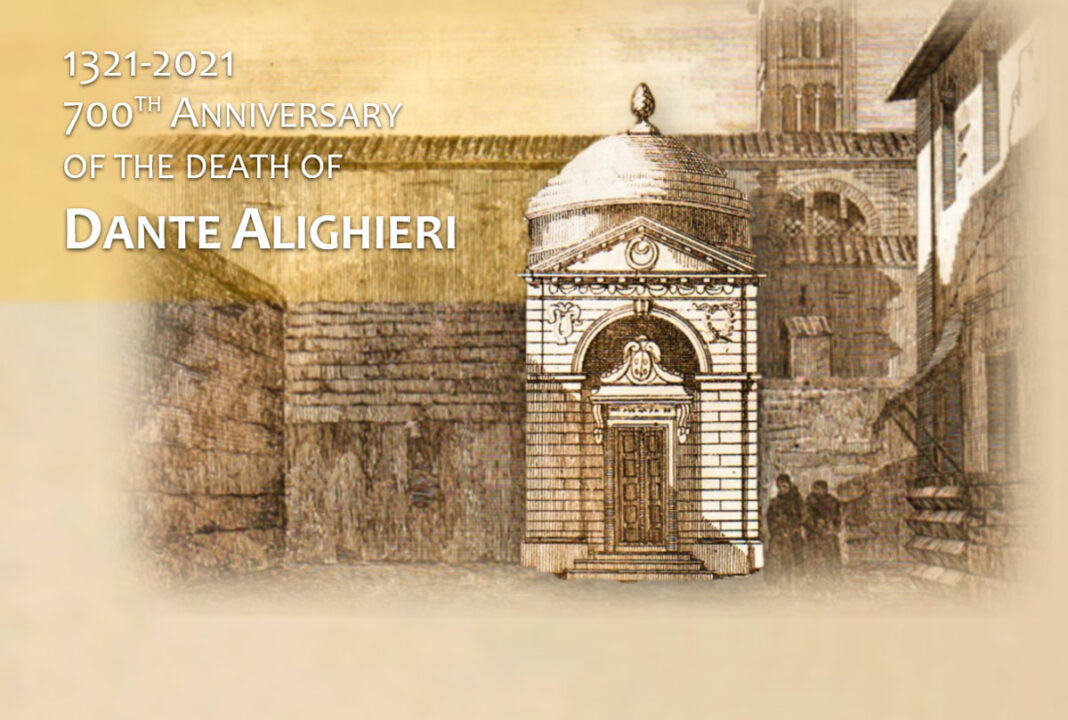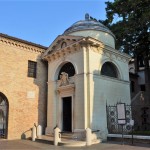The Story of the Bones
Writing about Dante’s death in Ravenna, Boccaccio said in his Trattatello in laude di Dante, that it occurred “on the day the Church celebrates the Exaltation of the Holy Cross” (XIV). Thus, a new page of Dante’s story began, starting with the custody of his body, but obviously not ending there.
As Boccaccio himself wrote, the dead body of Dante, “draped with the insignia of a poet,” was carried by Ravenna’s most illustrious citizens “to the dwelling place of the Friars Minor” (XV), the ancient Neonian Basilica of San Pietro Maggiore, then popularly called “San Francesco” and today also known as “Dante’s church.” Dante’s funeral was celebrated there and the body of the great poet was buried in the cemetery adjacent to the northern side of the church.

On the right is the “Quardraco of Braccioforte” and, in the foreground, the portico, to the left of which, close to the wall of the cloister of the friary, Dante Alighieri was buried in 1321.
However, polemics soon began between Ravenna and Florence over Dante’s body. The citizens of Florence, having “rediscovered” Dante’s remains thanks to the propaganda produced by Boccaccio, wanted to claim his body. It is recorded that already in 1429, the Commune of Florence presented a request to the noble Da Polenta family, Lords of Ravenna. Florence tried again more insistently in 1515, when Leo X, the fourth son of the Lord of Florence, Lorenzo “the Magnificent” de’ Medici, was seated on the chair of St. Peter. The Dante Center in Ravenna has an autograph by Girolamo Benivini, a Florentine humanist, dated around 1514-1515, with the draft of a letter that Lucrezia de’ Medici (1470-1553), eldest daughter of “the Magnificent,” was supposed to have copied, or had copied, and then sent to her brother the Pope. The pope had become the Lord of Ravenna when, in 1509, the city was placed under papal rule. The letter petitioned pope to order Dante’s bones returned to Florence.[1]
A letter from Pietro Cardinal Bembo (1470-1547) dated June 1, 1515, makes it clear that the pontiff had already granted his approval, and had thus sided with the well-known request made by the Medici Academy. However, despite the Florentines’ insistence, nothing happened. Then, on October 20, 1519, the Medici Academy sent the Pope their “Memorandum” signed by Benivieni and Michelangelo, among others, who undertook to construct a tomb for Dante, in a place of honor in Florence.
Taking advantage of the fact that the rulers of Ravenna were, at that time, relegated to Cesena because of their opposition to a new tax that the papal government had imposed on their city, the Florentines finally decided it was time to realize their long-standing intention. However, by then it was too late.
“When the Franciscans learned that the pope had given his permission for the Florentines to remove Dante’s bones and transfer them to Florence, the friars secretly came down from their cells to the main cloister. They found the place in the wall that corresponded with Dante’s tomb and began hammering away to remove the bricks. The hammer blows echoed under the vaults and anguish gripped the souls of those witnessing. The friars broke through the first wall; then the next one that partially encased the sarcophagus. Then, they struck the marble of the sarcophagus. As the first blows of the chisel made their mark, the silence of the surroundings increased. A hole now penetrated the burial space, but it had to be enlarged. The work continued and anxiety grew. Finally, the craftsmen’s eyes and hands were able to penetrate the sarcophagus and working by candlelight, they removed some small part of the skeleton. Now in the presence of the mortal remains of the divine poet, the friars began to pray the Office of the Dead; their voices murmured softly between the arches. Using a thin pole and an iron tool, they were able to pull the farthest bones out of the hole. Finally, they grasped the skull, but the opening of the hole was still too narrow for the skull to pass through. They wondered if it might be better to break the skull. However, they concluded it should never be broken. Instead, they would enlarge the opening, further breaking the sarcophagus. The skull however, or rather “the precious casket” which housed the brain that imagined the realms beyond the grave in his immortal poem, would remain intact! The work of the chisel resounded again; a worker’s hand reentered the space while everyone waited, almost holding their breath, until finally the skull came out of its dark and damp niche.

The rescue work was complete; the friary fell silent again, and the bones of Dante Alighieri remained preserved in Ravenna.”
This is how Corrado Ricci, in his famous “L’ultimo rifugio di Dante” [Dante’s Last Refuge] imagined the moving scene of Dante’s bones being extracted.[2] Ricci believed that the event took place between 1515 and 1519: “It does not seem possible, however, to extend this timeframe and conjecture that it took place in 1519 after the Memorandum came out. It may well be that word reached Ravenna earlier, after the first concession of Leo X, for which the two letters of June 1515 were written, and it was this that prompted the friars of St. Francis to remove the bones from the tomb.”[3]
Ricci goes on, “And so it was that the friars saved so much treasure in Ravenna.”[4]
Still, we do not know what actually motivated the friars and what fueled their opposition to transferring Dante’s bones to Florence, where, in any case, Dante had hoped to return to obtain the poet’s crown in the “bel San Giovanni” [handsome St. John] (Inferno XIX 17), where he was baptized (cf. Paradiso XXV 7-9), and dreamed of a glorious end to his political exile thanks to his poem.[5]

On the lid is written, “Dantis ossa a me Fra Antonio Santi hic posita anno 1677 die 18 octobris”.
(On the inside, however, is written: “Dantis ossa a me denuper revisa die 3 junii 1677”).
After their “removal,” the bones were probably kept in the friary; for how long, we do not know. They were certainly there in 1677 when Friar Antonio Santi (1644-1703), who was the Superior and Chancellor of the community in Ravenna, made a double-certified recognition, writing large letters in black ink on the wooden box in which the bones were later found. However, it was decided to hide them again in 1810, when Napoleonic law decreed that all religious Orders were to be suppressed and their goods confiscated. The friars were ordered to abandon their friary in Ravenna. Before they left, they buried Dante’s bones under the threshold of a walled door, a few steps from his new tomb, perhaps with the hope of recovering them at a more favorable time in the near future. (Dante’s new tomb was built between 1780 and 1782 at the behest of Luigi Cardinal Valenti Gonzaga. It was designed by the architect Camillo Morigia of Ravenna.) The friars were unable to return right away and all memory of the bones was lost until May 27, 1865, when the bones were rediscovered during some restoration work in the church, and the adjacent area, in preparation for the 600th anniversary of the birth of the poet. This prompted great joy and solemn celebration. The bones were finally interred in their permanent resting place, where they remain today.
[1] Gino Zanotti, La biblioteca del Centro Dantesco in Ravenna. Dai manoscritti alle edizioni del Settecento, Ravenna, Longo, 2001, pp. 52-53
[2] Corrado Ricci, L’ultimo rifugio di Dante, new edition with 47 illustrations, introduction and updating appendix by Eugenio Chiarini, Ravenna, Edizioni Dante by A. Longo, printed 1965, pp. 404-405.
[3] Ibid. p. 403
[4] Corrado Ricci, work cited. p. 404.
[5] Cf. Giuseppe Ledda, Dante poeta dell’esilio, in “IBC” XXIII, 2015, 3 (Online here at rivista.ibc.regione.emilia-romagna.it).

















